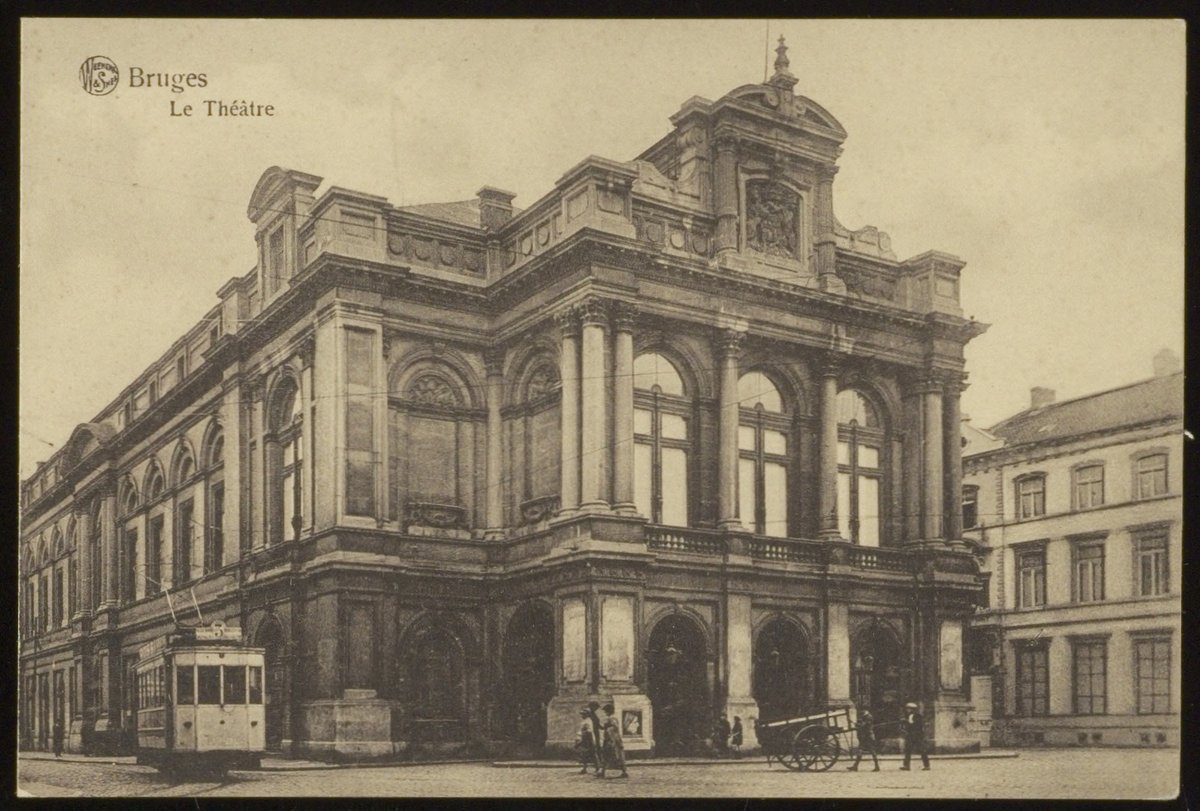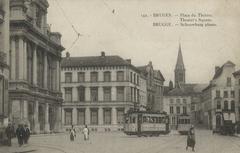
Adriaan Willaertstraat Bruges Visiting Hours, Tickets, and Historical Sites Guide
Date: 15/06/2025
Introduction
Adriaan Willaertstraat, located in the cultural and historic heart of Bruges, Belgium, is a captivating destination that intertwines the city’s rich history, neoclassical architecture, and vibrant local life. Named in honor of Renaissance composer Adriaan Willaert—an influential figure in European music—the street offers visitors a unique glimpse into Bruges’ artistic legacy and urban evolution. From its medieval origins and 19th-century transformation alongside the Royal City Theatre (Koninklijke Stadsschouwburg), to today’s lively Theater Quarter, Adriaan Willaertstraat is both a symbol of the city’s past and a hub for contemporary culture (Inventaris Onroerend Erfgoed).
Whether you are a history enthusiast, architecture lover, music aficionado, or traveler seeking authentic local experiences, this detailed guide provides practical information, cultural insights, and travel tips to help you fully appreciate Adriaan Willaertstraat and its surroundings.
Table of Contents
- Discover Adriaan Willaertstraat: A Cultural Gem in Bruges
- Origins and Naming of Adriaan Willaertstraat
- Urban Development and Architectural Evolution
- Integration into Bruges’ Theater Quarter
- Socioeconomic Shifts and Mixed-Use Character
- Preservation and Heritage Status
- Relationship to Medieval Bruges
- Visitor Information: Hours, Tickets, and Accessibility
- Photographic Highlights
- Nearby Attractions and Cultural Experiences
- Local Café and Culinary Culture
- Frequently Asked Questions (FAQ)
- Practical Tips for Visitors
- Conclusion and Further Resources
- References
Discover Adriaan Willaertstraat: A Cultural Gem in Bruges
Adriaan Willaertstraat is a picturesque street in Bruges’ vibrant Theater Quarter, renowned for its harmonious neoclassical architecture, tranquil atmosphere, and cultural importance. This guide will help you explore the street’s historical significance, practical visitor information, must-see sites, and insider tips for a memorable experience.
Origins and Naming of Adriaan Willaertstraat
Originally known as Eistraat until 1866, Adriaan Willaertstraat’s roots trace back to the late medieval era. The renaming honored Adriaan Willaert (c. 1490–1562), a celebrated Flemish composer whose work profoundly influenced the European Renaissance music scene. This change coincided with the area’s redevelopment into a cultural hub, underscoring Bruges’ dedication to the arts (Inventaris Onroerend Erfgoed).
Urban Development and Architectural Evolution
19th-Century Transformation
The street underwent significant transformation between 1869 and 1871, aligning with the construction of the Koninklijke Stadsschouwburg (Royal City Theatre). This redevelopment reflected a broader European trend of creating dedicated cultural quarters, with Adriaan Willaertstraat’s northern side featuring elegant neoclassical façades, uniform cornices, and refined proportions—a testament to 19th-century urban sophistication (Inventaris Onroerend Erfgoed).
Architectural Features
- Symmetrical façades with subtle ornamentation
- Tall, regularly spaced windows
- Saddle or hipped roofs typical of the era
- Cornices and pilasters enhancing the grandeur
A notable highlight is the former bank building from 1832, now home to Coffeebar Adriaan, which evokes the ambiance of grand European coffeehouses (Coffeebar Adriaan). The southern side of the street is dominated by the imposing Stadsschouwburg façade.
Integration into Bruges’ Theater Quarter
Adriaan Willaertstraat sits at the heart of Bruges’ Theaterkwartier, a district designed to foster artistic life. The Royal City Theatre, inaugurated in 1869, remains the focal point, drawing culture lovers and supporting local hospitality businesses. The street’s development mirrors Bruges’ ambition to celebrate its rich artistic heritage (Inventaris Onroerend Erfgoed).
Socioeconomic Shifts and Mixed-Use Character
From the late 19th century onward, Adriaan Willaertstraat has balanced residential, commercial, and leisure uses. Elegant townhouses catered to the middle class, and today, a mix of cafés, restaurants, and coworking spaces attract locals, artists, and tourists. Coffeebar Adriaan stands out for its welcoming atmosphere and high-quality coffee (Coffeebar Adriaan).
Preservation and Heritage Status
Adriaan Willaertstraat is part of Bruges’ protected neoclassical heritage and contributes to the city’s UNESCO World Heritage status. The preservation of its façades and the Stadsschouwburg maintains the street’s 19th-century charm, while allowing for contemporary uses (GigglyGarden).
Relationship to Medieval Bruges
Although largely 19th-century in appearance, Adriaan Willaertstraat connects to Bruges’ medieval core, linking Kuipersstraat and Vlamingstraat. These streets are lined with medieval and early modern buildings, such as Huis Ter Beurze and the Saaihalle, reflecting the city’s layered history (Coffeebar Adriaan).
Visitor Information: Hours, Tickets, and Accessibility
Location and Access
- Central Location: Easy walking distance from Markt and Burg squares.
- Public Transport: Closest bus stop is Stadsschouwburg.
- By Car: Ezelstraat car park is nearby.
Visiting Hours and Tickets
- Street Access: Open 24/7 to the public.
- Royal City Theatre: Box office open 10:00–18:00 on performance days; check official schedules for event times. Tickets range from €15–€45, available online or at the box office.
Accessibility
- Pedestrian-Friendly: Flat terrain, suitable for most visitors.
- Mobility Needs: Most venues, including Coffeebar Adriaan, are accessible. Some historic buildings may have limited access; check in advance.
Photographic Highlights
- Neoclassical façades: Elegant architecture along the street.
- Royal City Theatre: Imposing side façade.
- Street life: Locals and visitors enjoying the vibrant atmosphere.
Nearby Attractions and Cultural Experiences
- Huis Ter Beurze: Medieval guild house.
- Saaihalle: Historic trading hall.
- Jeruzalemkerk (Jerusalem Church): 15th-century church with unique artifacts (The Crazy Tourist).
- Windmills of Bruges: Panoramic city views.
- St. Salvator’s Cathedral and Church of Our Lady: Regular music concerts and art treasures.
Local Café and Culinary Culture
Coffeebar Adriaan at number 7 is renowned for its specialty coffee, pastries, and welcoming environment. The café’s décor blends historical charm with modern comfort, making it a favorite among locals and visitors alike, especially for breakfast or a midday break (Coffeebar Adriaan; Edible Reading). The surrounding Sint-Anna neighborhood offers additional dining and shopping options, including independent boutiques and brasseries (Odevaere).
Frequently Asked Questions (FAQ)
Q: What are the visiting hours for Adriaan Willaertstraat?
A: The street is publicly accessible at all hours. The Royal City Theatre and cafés have specific opening times.
Q: Do I need a ticket to visit Adriaan Willaertstraat?
A: No ticket required to walk the street; tickets are needed only for theatre performances.
Q: Is the street accessible for people with disabilities?
A: The street is generally accessible, but some cobblestones and historic venues may present challenges. Contact individual venues for details.
Q: Are guided tours available?
A: Yes, walking tours often include the Theater Quarter and Adriaan Willaertstraat; check with local tour operators.
Q: What are nearby must-see attractions?
A: Huis Ter Beurze, Jeruzalemkerk, Markt Square, and the city’s windmills are all within easy reach.
Practical Tips for Visitors
- Footwear: Wear comfortable shoes for cobbled streets.
- Weather: Bruges can be rainy; check forecasts and bring appropriate clothing.
- Language: Dutch is official, but English is widely spoken.
- Transport: Use public transport or bicycles; parking is limited in the center.
- Photography: Early morning and dusk offer the best light for photos.
- Dining: Coffeebar Adriaan is open Wednesday–Sunday, 08:30–17:00; check for special events and exhibitions.
Conclusion and Further Resources
Adriaan Willaertstraat offers a multifaceted Bruges experience, combining rich history, elegant architecture, vibrant café culture, and easy access to top attractions. Whether attending a concert at the Royal City Theatre, savoring a coffee at Coffeebar Adriaan, or exploring the tranquil Sint-Anna district, visitors will find ample opportunities to immerse themselves in the city’s unique heritage.
For up-to-date event schedules, ticket bookings, and insider tips, download the Audiala app. Explore our related guides for more on Bruges’ historical sites and cultural highlights.
References
- Inventaris Onroerend Erfgoed
- Visit Bruges
- Coffeebar Adriaan
- Edible Reading
- The Crazy Tourist
- Odevaere
- GigglyGarden
- Audiala app











































































